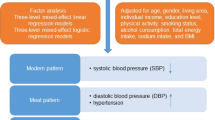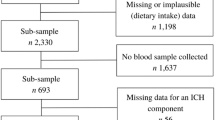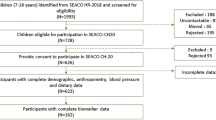Abstract
This paper aimed to systematically review the results of observational studies that investigated the association of dietary patterns with blood pressure and body adiposity markers in adolescents. Articles were searched in July 2020 in PubMed, Scopus, Web of Science, and Scientific Electronic Library Online (SciELO). Of the 3408 studies found, 24 fulfilled the inclusion criteria and were considered in this review. Almost all studies (n = 23) identified at least one unhealthy pattern, predominantly characterized as consumption of confectionery, refined grains, sweets, sweetened drinks, red meats, and processed meats. Fourteen of the twenty-four studies found a significant association between any dietary pattern and blood pressure and/or body adiposity markers. There was a positive association of dietary patterns - characterized by the consumption of foods rich in sodium, animal fat, refined carbohydrates, and low in fiber - with increased blood pressure and body adiposity. Our findings highlight the importance of studies with this scope, whose results can support the surveillance of adolescent’s health. However, considering the limited number of studies that found a significant association and their limitations, the present results should be interpreted carefully. More prospective studies are needed to determine how adherence to dietary patterns could influence blood pressure and body adiposity markers in the long term.
This is a preview of subscription content, access via your institution
Access options
Subscribe to this journal
Receive 12 print issues and online access
$259.00 per year
only $21.58 per issue
Buy this article
- Purchase on SpringerLink
- Instant access to full article PDF
Prices may be subject to local taxes which are calculated during checkout

Similar content being viewed by others
References
World Health Organization (WHO). Noncommunicable diseases country profiles 2018. Geneva: WGO; 2018. https://www.who.int/nmh/publications/ncd-profiles-2018/en/.
Moreno LA, Gottrand F, Huybrechts I, Ruiz JR, González-Gross M, DeHenauw S, HELENA Study Group. Nutrition and lifestyle in european adolescents: the HELENA (Healthy Lifestyle in Europe by Nutrition in Adolescence) study. Adv Nutr. 2014;5:615S–623S.
United States Department of Agriculture. A series of systematic reviews on the relationship between dietary patterns and health outcomes. 2014. https://nesr.usda.gov/are-prevailing-patterns-diet-behavior-population-assessed-using-factor-or-cluster-analysis-0. Accessed June 2020.
Schneider BC, Dumith SC, Orlandi SP, Assunção MCF. Diet and body fat in adolescence and early adulthood: a systematic review of longitudinal studies. Ciênc saúde coletiva. 2017;22:1539–52.
Hu FB. Dietary pattern analysis: a new direction in nutritional epidemiology. Curr Opin Lipido. 2002;13:3–9.
Michels KB, Schulze MB. Can dietary patterns help us detect diet-disease associations? Nutr Res Rev. 2005;18:241–8.
Ocké MC. Evaluation of methodologies for assessing the overall diet: dietary quality scores and dietary pattern analysis. Proc Nutr Soc. 2013;72:191–9.
Borges CA, Rinaldi AE, Conde WL, Mainardi GM, Behar D, Slater B. Dietary patterns: a literature review of the methodological characteristics of the main step of the multivariate analyzes. Rev Bras Epidemiol. 2015;18:837–57.
Silva DFO, Lyra CO, Lima SCVC. Dietary habits of adolescents and associated cardiovascular risk factors: a systematic review. Ciênc saúde coletiva. 2016;21:1181–96.
McNaughton SA, Ball K, Mishra GD, Crawford DA. Dietary patterns of adolescents and risk of obesity and hypertension. J Nutr. 2008;138:364–70.
Alizadeh M, Didarloo A, Esmaillzadeh A. Dietary patterns of young females and their association with waist circumference as a health Index in Northwest of Iran, 2007. Iran Red Crescent Med J. 2015;17:e17594
Hojhabrimanesh A, Akhlaghi M, Rahmani E, Sasan A, Masoumeh A, Maryam N, et al. A Western dietary pattern is associated with higher blood pressure in Iranian adolescents. Eur J Nutr. 2017;56:399–408.
Cunha DB, Bezerra IN, Pereira RA, Sichieri R. At-home and away-from-home dietary patterns and BMI z-scores in Brazilian adolescents. Appetite. 2018;120:374–80.
Oparil S, Acelajado MC, Bakris GL, Berlowitz DR, Cífková R, Dominiczak AF, et al. Hypertension. Nat Rev Dis Prim. 2018;4:18014.
Swinburn BA, Kraak VI, Allender S, Atkins VJ, Baker PI, Bogard JR. et al. The global syndemic of obesity, undernutrition, and climate change: the Lancet Commission report. Lancet. 2019;393:791–846. https://doi.org/10.1016/S0140-6736(18)32822-8. Epub 2019 Jan 27. Erratum in: Lancet. 2019.393:746.
World Health Organization. Global action plan for the prevention and control of NCDs 2013-20. Geneva: World Health Organization; 2013. http://www.who.int/nmh/events/ncd_action_plan/en/. Accessed June 2020.
Moher D, Liberati A, Tetzlaff J, Altman DG. Preferred reporting items for systematic reviews and meta-analyses: the PRISMA statement. PLoS Med. 2009;6:e1000097.
Brasil. Ministério da Saúde. Methodological Guidelines. Preparation of systematic review and meta-analysis of comparative observational studies on risk factors and prognosis. Brasília: Ministério da Saúde; 2014. http://bvsms.saude.gov.br/bvs/publicacoes/diretrizes_metodologicas_fatores_risco_prognostico.pdf. Accessed June 2020.
World Health Organization. Physical status: the use and interpretation of anthropometry. Report of a WHO Expert Committee. Technical Report Series No. 854. Geneva: World Health Organization; 1995. https://www.who.int/childgrowth/publications/physical_status/en/. Accessed June 2020.
Song Y, Park MJ, Paik H-Y, Joung H. Secular trends in dietary patterns and obesity-related risk factors in Korean adolescents aged 10 – 19 years. Int J Obes. 2009;34:48–56.
Joung H, Hong S, Song Y, Ahn BC, Park MJ. Dietary patterns and metabolic syndrome risk factors among adolescents. Korean J Pediatr. 2012;55:128–35.
Chan R, Chan D, Rd WL, Lo D, Li L, Woo J. et al. A cross-sectional study to examine the association between dietary patterns and risk of overweight and obesity in Hong Kong Chinese adolescents aged 10–12 years. J Am Coll Nutr. 2014;33:450–8.
Garba JA, Rampal L, Hejar AR, Salmiah MS. Major dietary patterns and their associations with socio-demographic characteristics and obesity among adolescents in Petaling District, Malaysia. Malays J Med Heal Sci. 2015;10:13–21.
Yang Y, Hu XM, Chen TJ, Bai MJ. Rural-urban differences of dietary patterns, overweight, and bone mineral status in Chinese students. Nutrients. 2016;8:537.
Emi NA, Gan WY, Mohd Shariff Z, Zaini AA, Shamsuddin NH, Appukutty M, et al. Associations of an empirical dietary pattern with cardiometabolic risk factors in Malaysian adolescents. Nutr Metab. 2020;17:28.
Appannah G, Pot GK, Huang RC, Oddy WH, Beilin LJ, Mori TA, et al. Identification of a dietary pattern associated with greater cardiometabolic risk in adolescence. Nutr Metab Cardiovasc Dis. 2015;25:643–50.
Ambrosini GL, Oddy WH, Robinson M, Therese A, Sullivan O, Hands BP, et al. Adolescent dietary patterns are associated with lifestyle and family psycho-social factors. Public Health Nutr. 2009;12:1807–15.
Ambrosini GL, Huang RC, Mori TA, Hands BP, O’Sullivan TA, Klerk NH, et al. Dietary patterns and markers for the metabolic syndrome in Australian adolescents. Nutr Metab Cardiovasc Dis. 2010;20:274–83.
Howe AS, Black KE, Wong JE, Parnell WR, Skidmore PML. Dieting status influences associations between dietary patterns and body composition in adolescents: a cross-sectional study. Nutr J. 2013;12:1–10.
Huybrechts I, Lioret S, Mouratidou T, Gunter MJ, Manios Y, Kersting M. et al. Using reduced rank regression methods to identify dietary patterns associated with obesity: a cross-country study among European and Australian adolescents. Br J Nutr. 2017;117:295–305.
Ambrosini GL, Emmett PM, Northstone K, Howe LD, Tilling K, Jebb SA. Identification of a dietary pattern prospectively associated with increased adiposity during childhood and adolescence. Int J Obes. 2012;36:1299–305.
Bull CJ, Northstone K. Childhood dietary patterns and cardiovascular risk factors in adolescence: results from the Avon Longitudinal Study of Parents and Children (ALSPAC) cohort [published correction appears in Public Health Nutr. 2019 Nov;22(16):3101-3105]. Public Health Nutr. 2016;19:3369–77.
Richter A, Heidemann C, Schulze MB, Roosen J, Thiele S, Mensink GBM. Dietary patterns of adolescents in Germany - Associations with nutrient intake and other health related lifestyle characteristics. BMC Pediatr. 2012;12:1–14.
Bodega P, Fernández-Alvira JM, Santos-Beneit G, de Cos-Gandoy A, Fernández-Jiménez R, Moreno LA, et al. Dietary patterns and cardiovascular risk factors in Spanish adolescents: a cross-sectional analysis of the SI! Program for Health Promotion in Secondary Schools. Nutrients. 2019;11:2297.
Ochoa-Avilés A, Verstraeten R, Lachat C, Andrade S, Van Camp J, Donoso S, et al. Dietary intake practices associated with cardiovascular risk in urban and rural Ecuadorian adolescents: a cross-sectional study. BMC Public Health. 2014;14:939.
Borges CA, Marchioni DML, Levy RB, Slater B. Dietary patterns associated with overweight among Brazilian adolescents. Appetite. 2018;123:402–9.
Alves MA, Retondario A, Bricarello LP, Fernandes R, Souza AM, Zeni LAZR. et al. Association between dietary patterns and overweight/obesity: a Brazilian national school-based research (ERICA 2013-2014). J Public Health. 2019;28:163–71.
Gutiérrez-pliego LE, Camarillo-Romero ES, Montenegro-Morales LP, Garduño-García JJ. Dietary patterns associated with body mass index (BMI) and lifestyle in Mexican adolescents. BMC Public Health. 2016;16:1–7.
Aounallah-Skhiri H, Traissac P, El Ati J, Eymard-Duvernay S, Landais E, Achour N, et al. Nutrition transition among adolescents of a south-Mediterranean country: dietary patterns, association with socio-economic factors, overweight and blood pressure. A cross-sectional study in Tunisia. Nutr J. 2011;10:38.
World Health Organization. Fact sheet N°394, Healthy diet. 2015. https://www.who.int/publications/m/item/healthy-diet-factsheet394. Accessed June 2020.
Ozemek C, Laddu DR, Arena R, Lavie CJ. The role of diet for prevention and management of hypertension. Curr Opin Cardiol. 2018;33:388–93.
Falkner B. Hypertension in children and adolescents: epidemiology and natural history. Pediatr Nephrol. 2010;25:1219–24.
Chen X, Wang Y. Tracking of blood pressure from childhood to adulthood: a systematic review and meta-regression analysis. Circulation. 2008;117:3171–80.
Bibiloni MM, Martínez E, Llull R, Pons A, Tur JA. Western and Mediterranean dietary patterns among Balearic Islands’ adolescents: socio economic and lifestyle determinants. Public Health Nutr. 2012;15:683–92.
Morinaka T, Wozniewicz M, Jeszka J, Bajerska J, Nowaczyk P, Sone Y. Westernization of dietary patterns among young Japanese and Polish females – a comparison study. Ann Agric Environ Med. 2013;20:122–30.
Simmonds M, Llewellyn A, Owen CG, Woolacott N. Predicting adult obesity from childhood obesity: a systematic review and meta-analysis. Obes Rev. 2016;17:95–107.
Bloch KV, Klein CH, Szklo M, Kuschnir MCC, Abreu GA, Barufaldi LA, et al. ERICA: prevalences of hypertension and obesity in Brazilian adolescents. Rev Saúde Pública. 2016;50:9s.
Urbina EM, Khoury PR, Bazzano L, Burns TL, Daniels S, Dwyer T, et al. Relation of blood pressure in childhood to self-reported hypertension in adulthood. Hypertension. 2019;73:1224–30.
Sacks FM, Svetkey LP, Vollmer WM, Appel LJ, Bray GA, Harsha D, et al. Effects on blood pressure of reduced dietary sodium and the Dietary Approaches to Stop Hypertension (DASH) diet. DASH-Sodium Collaborative Research Group. N. Engl J Med. 2001;344:3–10.
Currie C, Zanotti C, Morgan A, Currie D, Looze M, Roberts C et al. Social determinants of health and well-being among young people. Health behaviour in school-aged children (HBSC) study: International report from the 2009/2010 survey. Health policy for children and adolescents. Copenhagen: WHO Regional Office for Europe; 2012. https://www.euro.who.int/en/publications/abstracts/social-determinants-of-health-and-well-being-among-young-people.-health-behaviour-in-school-aged-children-hbsc-study. Accessed June 2020.
Funding
This work was supported by the Coordenação de Aperfeiçoamento de Pessoal de Nível Superior (CAPES), Brazil, through a Master grant (MEAN; Finance Code 001). However, CAPES had no role in the design, analysis or writing of this manuscript.
Author information
Authors and Affiliations
Contributions
MEAN and PRMR designed the study. MEAN and APM developed syntax for searching databases and prepared the manuscript. MEAN and MRS contributed to the literature searches, data extraction, and independent reviewing. BMG, DBC and PRMR formulated the research question and prepared the manuscript. All authors contributed to the writing of the manuscript and approved it.
Corresponding author
Ethics declarations
Conflict of interest
The authors declare that they have no conflict of interest.
Additional information
Publisher’s note Springer Nature remains neutral with regard to jurisdictional claims in published maps and institutional affiliations.
Supplementary information
Rights and permissions
About this article
Cite this article
Neves, M.E.A., Souza, M.R.d., Gorgulho, B.M. et al. Association of dietary patterns with blood pressure and body adiposity in adolescents: a systematic review. Eur J Clin Nutr 75, 1440–1453 (2021). https://doi.org/10.1038/s41430-020-00850-w
Received:
Revised:
Accepted:
Published:
Issue Date:
DOI: https://doi.org/10.1038/s41430-020-00850-w
This article is cited by
-
Association between sedentary behavior, screen time and metabolic syndrome among Chinese children and adolescents
BMC Public Health (2024)
-
Interplay of the Mediterranean diet and genetic hypertension risk on blood pressure in European adolescents: Findings from the HELENA study
European Journal of Pediatrics (2024)



